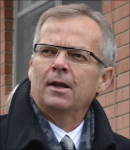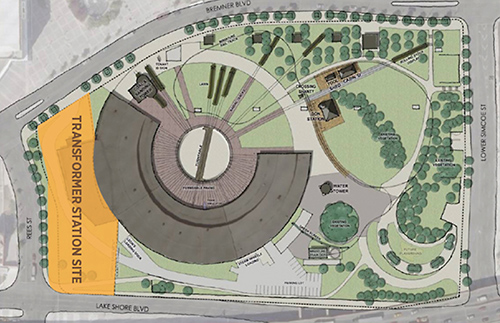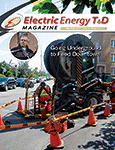EET&D : Why does downtown Toronto need a new transformer station?
Haines : In downtown Toronto, our grid is old and our station loads are nearly at capacity. We need a new station to ‘back up’ our Windsor Transformer Station in order to enable staged replacements of its end-of-life, air-blast switchgear. As well, we currently do not have station redundancy. Right now, Windsor Station supplies much of the financial district, the convention centre and the CBC headquarters, among many other large and important customers. In addition, the city is growing at an unprecedented rate. There are 189 high-rise buildings under construction, which is double the number in New York City (82 buildings) and this means increased demand on the electricity grid.
We currently operate five transformer stations in the downtown core. Four are near capacity. Overloading at Windsor Transformer Station is expected to occur by 2017. Overloads at the Esplanade, Strachan, and Cecil Transformer Stations are expected in 2018, 2022, and 2022 respectively.
This will be the first transformer station built in downtown Toronto since the 1960’s. The station will prop up capacity for these stations and provide additional capacity in anticipation of continued development.
EET&D : How will this station serve the future energy needs of downtown Toronto?
Haines : The latest economic report says that Toronto has moved ahead of Chicago and is now the fourth largest metropolitan area, by population, in North America. Between 2006 and 2011, the population in the city’s downtown increased by over 50 percent, while the population in the city as a whole increased by just over nine percent. Based on Toronto Hydro’s load forecast, between 2017 and 2022 anticipated load increases will exceed the ability of the company’s five downtown stations to handle demand. The new transformer station will address this issue. The station will add a total of 144 MVA of capacity, which is the equivalent to approximately 70 condo buildings.
Located in the heart of downtown Toronto, the station will power major Toronto institutions including the CBC, Rogers Centre, and the new Ripley’s Aquarium. It will also connect to new infrastructure along Queens Quay which is being revitalized as part of Waterfront Toronto’s vision.
EET&D : What is unique about this project?
Haines : There are a number of unique aspects of this project, but probably the most obvious is that the majority of the station will be built mainly underground. This is just the second underground transformer station in Canada - the first being in Vancouver. Once it’s complete, the station will be approximately 50,000 square feet, with three floors spanning 40 feet below grade. We’re also using more modern equipment like gas insulated transformers. This is the first installation in Canada using this type of equipment and one of the first in North America.
The station is also located on a designated heritage site, adjacent to Toronto’s landmark Roundhouse building. This means that special consideration must be made during construction. For instance, a Machine Shop located on the site, which was historically used for repairing rail cars, must be taken apart brick by brick to build the station and reassembled exactly as it was once the station is complete.
EET&D : Why build the station underground?
Haines : Because of its location in one of the busiest, most highly-populated areas of the city, building the station underground is the only option. Real estate is scarce and we don’t have room to build a sprawling above-ground transformer station. Housing everything underground reduces the station’s overall footprint and allows it to blend-in aesthetically with the neighbourhood.
EET&D : How will construction unfold?
Haines : With our recent approval from the Ontario Energy Board to proceed with the project, our crews have just completed pre-construction work to prepare the site, which included building a temporary roadway, relocating underground services, and cleaning up the Machine Shop. The station will be built under the existing Machine Shop, which will be re-assembled after construction of the station is complete. The Machine Shop will house the protection, control and station service equipment, while the major equipment (transformers, switchgear, cabling, etc) will be housed below. Electrical supply for the station will be taken from existing 115 kV electrical circuits within Hydro One’s Front Street tunnel, located 100 feet underground. From the tunnel, cables will be routed via a new underground cable tunnel to the new transformer station, where the 115 kV will be stepped down, through transformers, for distribution to customers. The new station is expected to be complete by the end of 2014.
EET&D : Many thanks Anthony for taking the time to speak with us and explain to our readers the upgrades Toronto Hydro is making to its electricity system to ensure Toronto Hydro continues to meet the ever-growing demands this large city places on electric power flow.
About the Interviewee:
 Anthony Haines is the President and Chief Executive Officer of Toronto Hydro Corporation and its subsidiaries, one of the largest urban electricity distribution companies in Canada. He is a seasoned leader with over 25 years of experience in the Canadian energy industry, including 15 years in various senior roles in the natural gas industry.
Anthony Haines is the President and Chief Executive Officer of Toronto Hydro Corporation and its subsidiaries, one of the largest urban electricity distribution companies in Canada. He is a seasoned leader with over 25 years of experience in the Canadian energy industry, including 15 years in various senior roles in the natural gas industry.
Mr. Haines has been a member of the Canadian Electricity Association board since 2006 and is actively involved with the Ontario Coalition of Large Distributors. He is a past board member of the Electricity Distributors Association. Mr. Haines serves as the Sector Chair for the United Way of Greater Toronto’s public service sector fund raising, and is actively involved with charities throughout Toronto.








